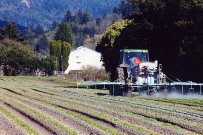One of our most important conservation groups protects one of the West’s rarest, oldest and most endangered fish.

- A green sturgeon negotiates an equally green Klamath River. Photo © Thomas Dunklin.
Here at Siskiyou Land Conservancy, we’re grateful for the work of the Center for Biological Diversity and other groups willing to trudge the long, arduous road of endangered species protection. The Center has gained first-time protection, through scientific petitions and legal action, for more than 360 species under the Endangered Species Act.
To see just how arduous it is to protect even a species as obviously on the brink of extinction as green sturgeon, check out CBD’s timeline detailing the petitioning and litigation history of getting the iconic fish protected.
The three original petitioners also included WaterKeepers Northern California, and the Environmental Protection Information Center under then Program Director Cynthia Elkins. Elkins served for the past six years as a director of Siskiyou Land Conservancy.
The Center’s press release on green sturgeon protection is below.
=-=-=-=-=-=-=-=-=-=-=-=-=-=-=-=-=-=-=-=-=-=
For Immediate Release, June 3, 2010
Contact: Jeff Miller, Center for Biological Diversity, (510) 499-9185
Protective Regulations Finalized for Southern Green Sturgeon
SAN FRANCISCO— The National Marine Fisheries Service finalized Endangered Species Act regulations Wednesday to protect the southern population of green sturgeon from “take” and other harmful activities. The take prohibitions make it unlawful to kill or harm southern green sturgeon and could require changes in operations of dams and water diversions, commercial and recreational fisheries, dredging operations, and pesticide applications to protect the green sturgeon, an ancient and imperiled migratory fish species that has survived since the Jurassic era.
“The southern green sturgeon population has fallen to precariously low numbers, and these regulations should help protect the few remaining spawning sturgeon from the Sacramento River from harm by water projects, overfishing, and pesticides,” said Jeff Miller, conservation advocate with the Center for Biological Diversity.
 The new regulations, created under section 4(d) of the Endangered Species Act, prohibit all unauthorized “take” of southern green sturgeon throughout their spawning and rearing range in the Sacramento, Feather, and lower Yuba rivers, as well as in the Sacramento-San Joaquin Delta and San Francisco Bay. Because of the similarity of appearance between southern and northern green sturgeon, any green sturgeon in marine environments, including the mouths of coastal rivers, estuaries, and marine waters in California, Oregon, and Washington, are protected from take.
The new regulations, created under section 4(d) of the Endangered Species Act, prohibit all unauthorized “take” of southern green sturgeon throughout their spawning and rearing range in the Sacramento, Feather, and lower Yuba rivers, as well as in the Sacramento-San Joaquin Delta and San Francisco Bay. Because of the similarity of appearance between southern and northern green sturgeon, any green sturgeon in marine environments, including the mouths of coastal rivers, estuaries, and marine waters in California, Oregon, and Washington, are protected from take.
The green sturgeon, Acipenser medirostris, is one of the most ancient fish species in the world, remaining unchanged in appearance since it first emerged 200 million years ago. Green sturgeon are among the largest and longest-living fish species found in freshwater, living for as long as 70 years, reaching 7.5 feet in length, and weighing as much as to 350 pounds. Sturgeon have a prehistoric appearance, with a skeleton consisting of mostly cartilage and rows of bony plates for scales. They have snouts like shovels and mouths like vacuum cleaners that are used to siphon shrimp and other food from sandy depths.
For more information about the green sturgeon, visit:
www.biologicaldiversity.org/species/fish/North_American_green_sturgeon/index.html
Background
In response to a 2001 Center listing petition and a subsequent lawsuit, the Fisheries Service in 2006 listed the southern green sturgeon population — fish in the San Francisco Bay and Delta that spawn in the Sacramento River basin, but migrate along much of the west coast from Mexico to Canada — as a threatened species under the Endangered Species Act. In 2009, the Fisheries Service designated broad areas of river, estuarine, bay, and coastal marine habitats in California, Oregon, and Washington as critical habitat for the southern population of green sturgeon.
Killing, injuring, harassing, hunting, capturing, or collecting green sturgeon without a federal permit under the Endangered Species Act are now activities considered “take,’’ as is harm from significant habitat modification or degradation that impairs sturgeon breeding, spawning, rearing, migrating, feeding, or sheltering. The 4(d) rule discusses specific activities likely to take or harm green sturgeon, including commercial and recreational fisheries, habitat-altering activities, impeded migration from dams and water diversions, entrainment during water diversions or dredging, application of pesticides and pollutants, and nonnative species introductions. Exemptions to the 4(d) rule allow for continued tribal fisheries, scientific research and monitoring activities, emergency rescue and salvage activities, and habitat restoration projects that are not considered to threaten green sturgeon.
In order to comply with the 4(d) rule, state commercial and recreational fisheries must submit fisheries management and evaluation plans to the federal Fisheries Service that prohibit retention of green sturgeon (zero bag limit), with measures to minimize incidental take of sturgeon. In 2007, California and Washington revised fishing regulations to prohibit retention of green sturgeon, and Oregon prohibited retention of green sturgeon in lower Columbia River recreational fisheries. For commercial fisheries, the retention of green sturgeon has been prohibited in the Columbia River since 2006 and statewide in Washington since 2007. California has prohibited commercial fishing for sturgeon since 1917. American Indian fisheries for green sturgeon will be required to develop tribal resource-management plans for sturgeon. The only tribal take of southern green sturgeon is as bycatch in salmon and white sturgeon fisheries conducted by the Quinault tribe in coastal Washington waters. In 2006, the Quinault tribe implemented zero retention of green sturgeon for their Grays Harbor fishery. The Yurok and Hoopa tribes harvest green sturgeon in the Klamath River in California, but most fish are believed to be from the northern population, which is not federally protected. Overall, the take of green sturgeon in tribal fisheries has been low compared to that of nontribal fisheries.
Like salmon, sturgeon are anadromous, migrating to the ocean and returning to freshwater to spawn. Only three known green sturgeon spawning grounds remain, in the Sacramento and Klamath rivers in California and the Rogue River in Oregon. Between four and seven spawning populations have already been eliminated in California and Oregon. The estimated abundance of green sturgeon in the Sacramento River plummeted by 95 percent between 2001 and 2006, with only an estimated 50 pairs of spawning fish remaining. Severe declines in both green and white sturgeon parallel the collapse of other fish species in the Sacramento-San Joaquin Delta, such as delta smelt, longfin smelt, Sacramento splittail, threadfin shad, and striped bass, due to the combined effects of Delta water diversions and exports, pesticides and pollution, and introduced species.
###
The Center for Biological Diversity is a national, nonprofit conservation organization with more than 260,000 members and online activists dedicated to protecting endangered species and wild places. www.biologicaldiversity.org

